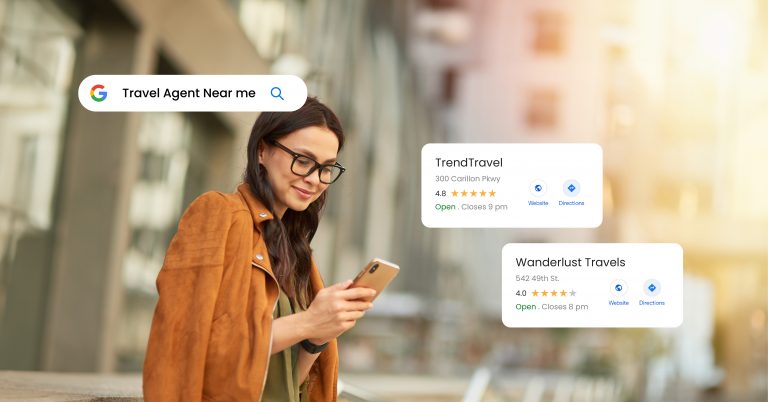Most customers use online search to look for local services and products nearby. In fact, 98% of consumers use the Internet to find information about local businesses. This is great news for you!
Here’s why: If your business is well-optimized for local SEO, your business will be visible on search engines to customers in your area. The more visible and aware your consumers are about your business, the more likely you are to turn them into in-store customers.
To help you optimize your local SEO, we’ve listed the top 7 things you should do to ensure your business is found. By the end of this blog, you’ll know exactly how to implement local SEO for your business and get customers rushing to you!
No online search strategy is complete without a Google Business Profile (previously known as Google My Business) listing. Think of it as an online address for your business. Using this information, customers will know exactly where you’re located and what services you offer, and they can even contact you for additional information.
Here’s how to optimize your Google My Business listing:
Besides SEO benefits, this feature also creates a cohesive online experience for your customers, making it easier for them to find you. If you’re looking for an easier way to manage your listings, partners such as SingleInterface can help you manage your online business listings seamlessly for amplified visibility.
Online directories are websites or platforms that list businesses, usually categorized by location, industry, or both. Similarly, citations refer to mentions of a business’s name, address, and phone number, on other websites.
In the local SEO realm, maintaining consistency and accuracy of your NAP (Name, Address, and Phone Number) is crucial for success. This simple yet effective process helps build credibility and trust among customers.
Here are some best practices:
Think of a local SEO audit as a health checkup for your business’s online presence. It’s all about figuring out what’s already working and what might need a little tweaking.
Begin by analyzing your current activities. This includes examining your keywords, content, and overall website user experience. This will give you insights into how easy it is for your customers to find you online.
You can also analyze your competitors to see what they’re doing right and what gaps they face. This will help you fill those gaps and determine what you can do differently to stand out.
If your website is a busy city, your internal links are like roads that connect everything together. The more well-connected your roads are, the easier navigation will be.
Internal links have become an important ranking factor, signaling to search engines the importance and relevance of your pages. This makes it easier for the engine bots to search and index your content, improving your chances of ranking high.
Here are some best practices:

Optimizing technical details significantly enhances your customer’s user experience and boosts your site’s performance in local search rankings. These aren’t just good-to-have features but are essential for your local business’s SEO success.
Here are some key things to keep in mind:
As search engines continue to get smarter, businesses can create content for their customers instead of appeasing search engines. This is where an effective writing strategy comes in.
You can create content targeted to your consumers to make your business truly unique. For instance, if you run a local travel business, writing about the ‘Top 5 places to visit’ is great for attracting a wider crowd.
You can also dive deeper into more specific topics like ‘Top 5 dishes in restaurant X’ to cater to more specific customer queries and get more traffic on your website.
Note: Make sure to sprinkle in local keywords organically to increase the chances of your content getting discovered.
Did you know that 77% of customers read through online reviews when searching for local businesses?
This is a goldmine for local businesses to attract more customers. Actively engaging with reviews on platforms like Google My Business, TripAdvisor, and Yelp can significantly improve your brand’s presence and build a solid brand reputation among consumers.
Here’s how you can make the most of every review:
Congratulations! You’re well on your way to mastering local SEO for your small business. The key to success lies in experimenting, improving, and updating!
Remember, local SEO is not a one-and-done task. It requires continuous effort and updates, with regular audits and testing to analyze what’s working and what needs improvement. Get this right, and you’ll ace it!
The good news is that you don’t have to do it alone! SingleInterface is an all-you-need marketing-to-commerce platform for all your business needs. Have questions? Talk to us and get answers!